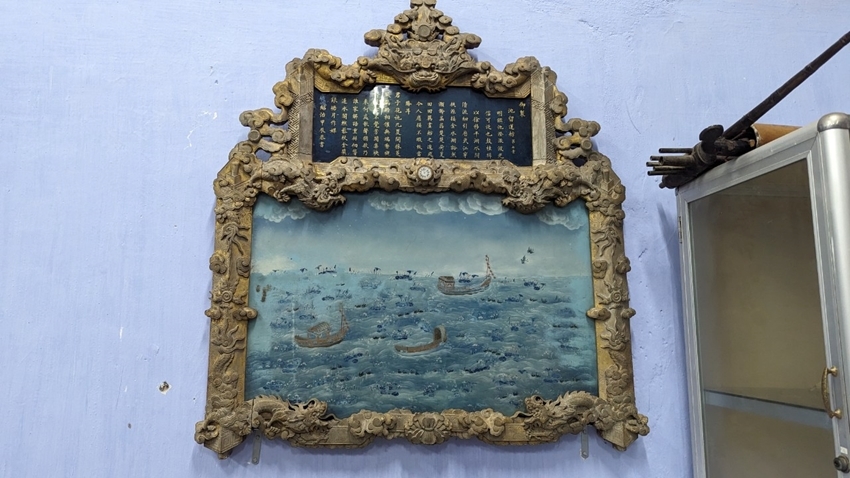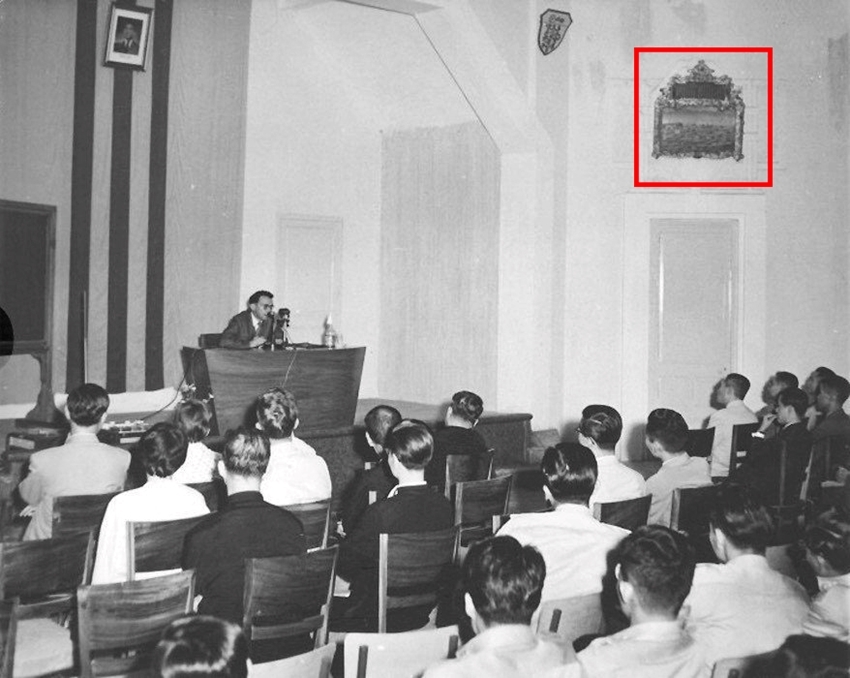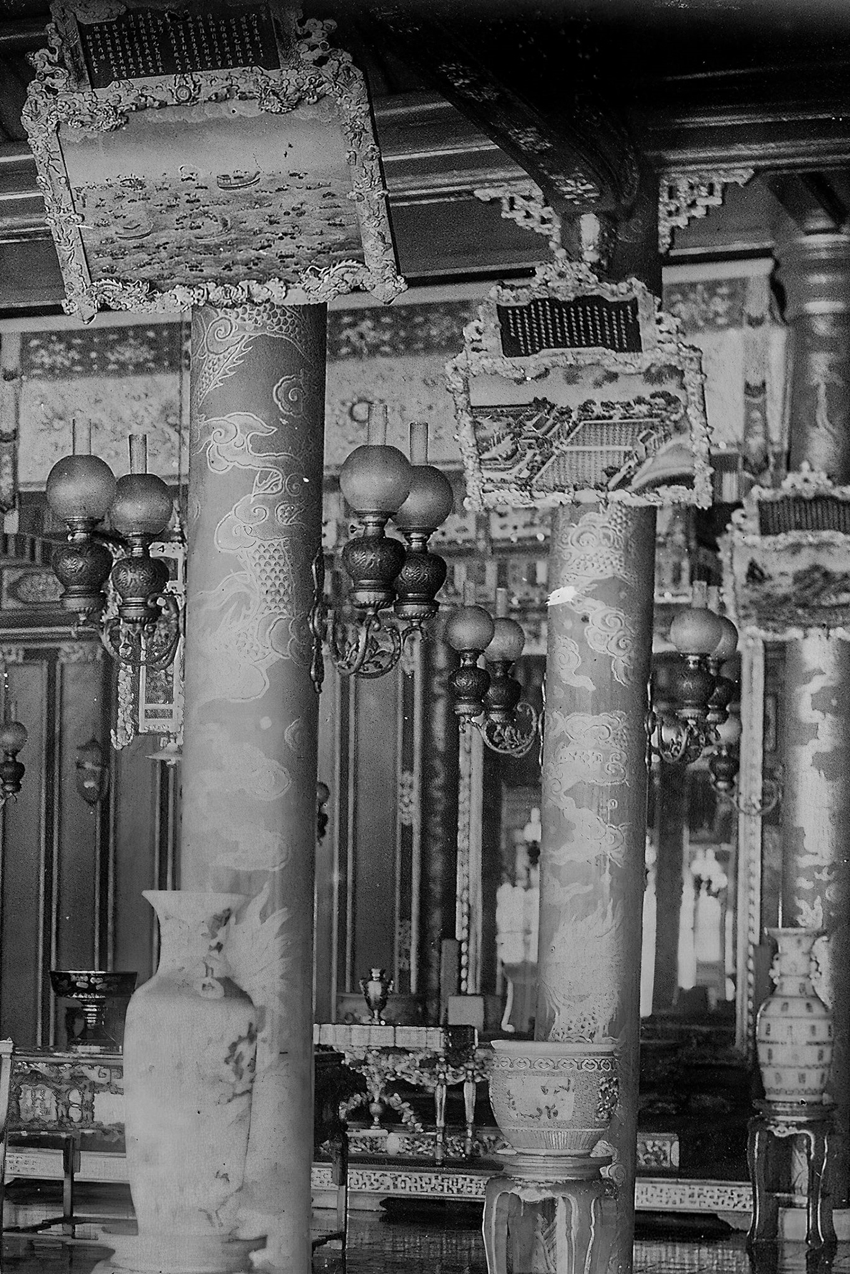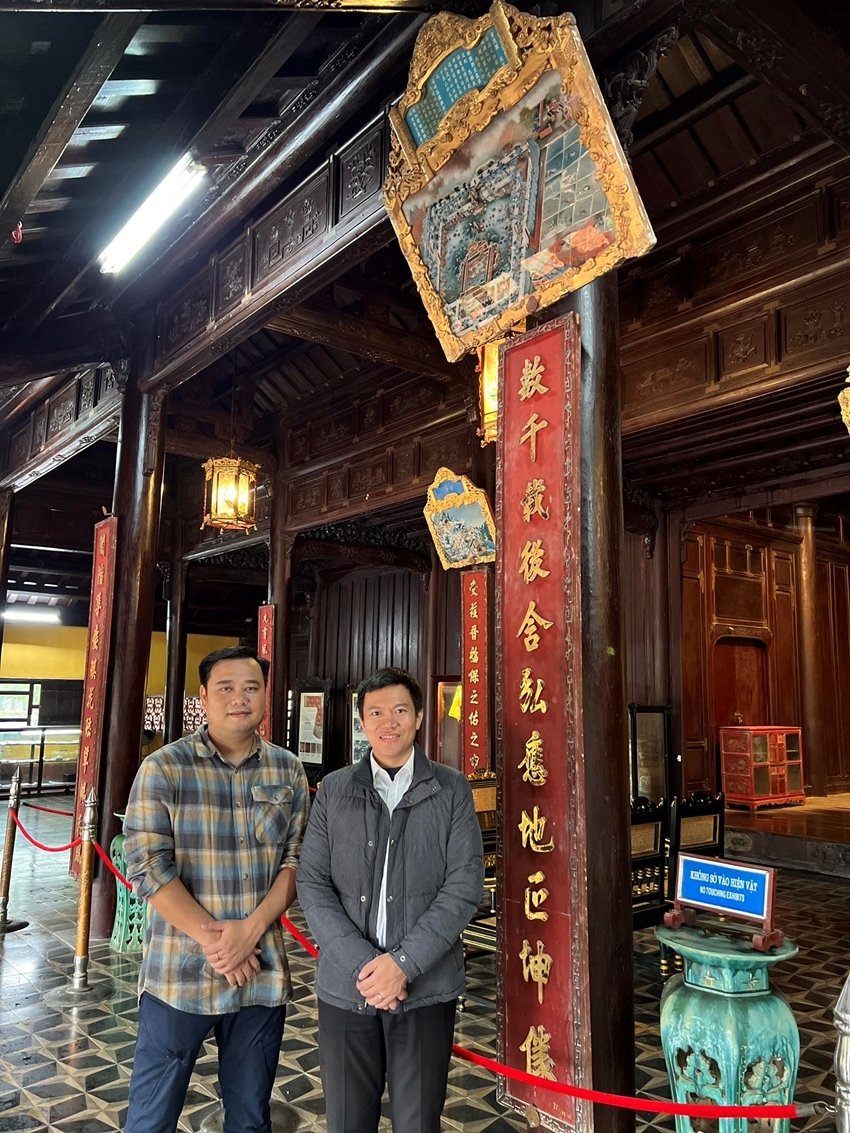 |
| “Tri luu lien phang,” the glass painting currently hung at the Department of History, College of Sciences, Hue University |
“Tri luu lien phang” used to be in Can Chanh Palace
In the process of digitalizing documentary photos for the restoration of Can Chanh Palace, the research team led by Nguyen Tan Anh Phong suddenly discovered that the glass painting at the Department of History, College of Sciences, Hue University is the precious painting which used to be hung at Can Chanh Palace in the Imperial City.
The painting is named “Tri luu lien phang,” depicting three small boats surfing on the waves. The painting is about 105cm high. Its frame is carved with five dragons with five claws in clouds symbolizing the emperor’s authority. On the painting is a carved a poem which is identified as composed by emperor Thieu Tri dated in 1845.
From the digitalized color documentary films about the interior of Can Chanh Palace, Anh Phong and his collaborators identified the content of the glass paintings hung inside Can Chanh Palace and were surprised to discover that some of those paintings still exist to these days. He also discovered the painting “Tri luu lien phang” was hung on the wooden column No. C6 in Can Chanh Palace.
 |
| The painting is seen in a photo taken in 1957 on the occasion of the establishment of Hue University. Photo: Nguyen Tan Anh Phong |
While searching for information on the Internet, Anh Phong spotted 2 glass paintings on a photo posted on the Facebook of a friend participating in an activity at the Department of History, College of Sciences, Hue University. He accessed the data and found a better photo of this glass painting. “We’re sure it’s exactly the original glass painting “Luu tri lien phang.” This is good news for the heritage of our province in general and the restoration process of Can Chanh Palace in particular,” said Anh Phong.
In addition to the painting “Tri luu lien phang” at the Department of History, College of Sciences, Hue University, there hung another glass painting named “Lang tap quan phuong,” depicting an ancient Phu De (princes’ and princesses’ residences.) Some historical and cultural researchers theorize that painting used to belong to Can Chanh Palace too.
According to Phong, while looking for reasons why those paintings ended up there, he found that it was Mr. Ngo Dinh Diem who presented them to Hue University on the occasion of its establishment in 1957. The paintings have been circulating within Hue University until now. As informed by a researcher, Prof. Nguyen Quoc Loc had those paintings brought to the Department of History, College of Sciences from the hall of Hue University when the Museum of Ethnology was founded there in 1978-1979.
 |
| In this photo of Can Chanh Palace the painting “Tri luu lien phang” was hung on the first column |
Wishing the antiques to be “reunited”
As a person devoted himself to the restoration of the heritage, Nguyen Tan Anh Phong is very happy to learn that the antique artifacts which used to be hung in the important palace still exist in Hue.
“We hope that these artifacts will be “reunited” home so that they will be carefully kept and digitalized to promote their values in the conservation of the heritage. We suggest that those who are concerned carry out the returning as soon as possible,” said he.
Regarding this issue, according to Mr. Hoang Viet Trung, Director of Hue Monuments Conservation Center, the Center once asked the College of Sciences, Hue University to bring those two paintings back to the Center for better protection and display. The college said they would consider that suggestion.
Can Chanh Palace was built during the third year of emperor Gia Long’s era in 1804. That was the place where kings of the Nguyen Dynasty held courts, received ambassadors, and gave royal banquets. In the Imperial City, Can Chanh Palace was just second to Thai Hoa Palace where the throne was located. This palace was completely destroyed in 1947 during the war and is about to be restored by Hue Monuments Conservation Center with a total fund of nearly VND200 billion.
 |
| Nguyen Tan Anh Phong (left) next to the glass painting, which used to be displayed in Can Chanh Palace, spotted at Dien Tho Palace now |
In the process of researching and commenting on the restoration of Can Chanh Palace, helping the heritage to be restored exactly, Nguyen Tan Anh Phong discovered many valuable pieces of information. In addition to the glass painting at the Department of History, the large mirror that used to be put behind the king’s seat in Can Chanh Palace was identified by Nguyen Tan Anh Phong to be present in Huu Vu now. Another glass painting is currently in Dien Tho Palace. We are happy that those antiques belonging to Can Chanh Palace still exist. Through the height of the mirror, we can learn about the height of the columns inside the palace.
“We use the method of perspective projection on documentary photos to determine sizes of constructions including all their columns and items. We choose the original glass paintings and the original big mirror left at Huu Vu as references to decide on other measurements. The actual measurements of the glass painting “Tri luu lien phang” and the measurements got from perspective projection are similar with a very small error of 8,7mm. Of course, this is not the final conclusion; we need more comparison and contrast with the measurements provided by the research team of the project,” analyzed Nguyen Tan Anh Phong.
